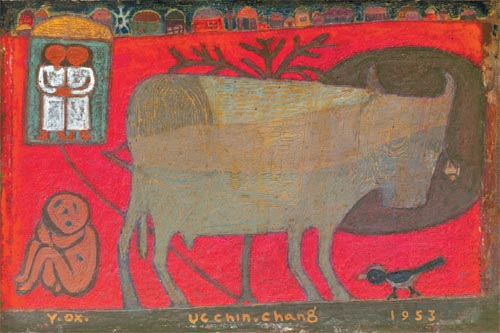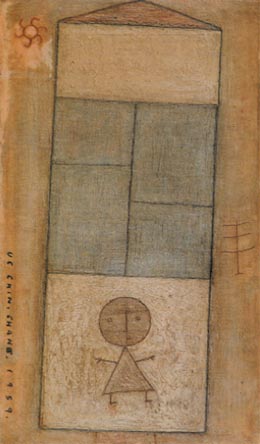Artworks at rest in a sea of innocence

“Ox,” a 1953 oil painting by Chang Ucchin, is now on display at Gallery Hyundai’s retrospective of the artist.
Unlike his contemporaries, Chang Ucchin (1917-1990) painted lighthearted works with a cheerful atmosphere. Most of his paintings feature common objects such as trees, magpies, houses and the sun and moon. The simplicity with which the forms are rendered stands in stark contrast to the primary colors he used to paint them.
Art lovers can now see these works in a large-scale retrospective of the artist that continues until Feb. 27 at Gallery Hyundai, which is located on the art street east of Gyeongbok Palace in central Seoul.
Viewers can also examine the contrast between Chang’s works and those of his peers in an exhibition titled “Blossoms on Yeoliji” at Kim Chong Yung Museum in Pyeongchang-dong, central Seoul, through Feb. 11.
Gallery Hyundai, which last year held a rare large-scale retrospective of Park Soo-keun, another representative modern artist of Korea, is now exhibiting about 70 paintings and drawings by Chang that date from between 1939 and 1990. The exhibition includes five works that are being unveiled to the public for the first time, including the 1953 oil painting “Ox.”

“House and the Child,” a 1959 painting by Chang is now being exhibited at the Kim Chong Yung Museum. Provided by the institutions
Chang’s “Self Portrait,” painted in 1951, “exudes a feeling of peace and nostalgia, as well as a bit of humor, even though it was produced during the Korean War,” according to the Chang Ucchin Foundation, which is operated by the artist’s family.
But his paintings are far from childish optimism.
“His works consistently show some tranquil and transcendental qualities,” said Sung Eun-jin, head of public relations at Gallery Hyundai. “His bereaved family said that he continued to confine himself to his house to paint, even in 1988 when all of Korea was caught up in the excitement of the Summer Olympics.”
Tranquility and transcendence are present in one of the last works he made before his death, “The Night and an Old Man” (1990). In it, an old man in a white gown, who could be the artist himself, floats in the sky, leaving behind on earth all the things he frequently painted - mountains, trees, a house, a magpie and a child.
In this sense, Chang’s paintings resemble the wisdom of those who have reached enlightenment in Zen Buddhism. In fact, he frequently visited Buddhist temples in the 1970s and was later given a Buddhist name, Bi Gong, which means “nonvoid,” by Zen Master Kyong Bong, according to the Chang Ucchin Foundation.
Chang’s paintings can also be seen in an exhibition at the Kim Chong Yung Museum, which was established to commemorate the Korean sculptor, who was another important figure in modern Korean art history. In addition to Chang’s work, the exhibit shows sculptures by Kim (1915-1982) and abstract paintings by Kim Whan-ki (1913-1974), a beloved Korean painter.

“Mountain and the Moon,” left, by Kim Whanki and “Legend,” right, an iron sculpture by Kim Chong-yung are part of the “Blossoms on Yeoliji” show at the Kim Chong Yung Museum. Provided by the museum
The title of the exhibition is “Blossoms on Yeoliji.” Yeoliji are trees with different roots whose branches become so entangled with one another that they look like one tree.
The three artists became friends and exchanged views about art in the 1950s, when they were all professors of fine arts at Seoul National University, according to the museum.
“They lived in the same period, when the influence of Western modern art was strong in Korea,” Choi Jong-tae, the director of the museum, said. “However, they were not overwhelmed by Western art. Rather, they combined Eastern and Western elements.”
*The Chang Ucchin retrospective continues at Gallery Hyundai through Feb. 27. Admission is 3,000 won ($2.70) for adults. Hours are 10 a.m. to 6 p.m. Tuesdays to Sundays. Go to Anguk Station, line No. 3, exit 1, and walk for about 10 minutes. For details, call (02) 2287-3500 or visit www.galleryhyundai.com.
The “Blossoms on Yeoliji” exhibition is at the Kim Chong Yung Museum through Feb. 11. Admission is free. Hours are 10:00 a.m. to 5:00 p.m. Tuesdays to Sundays. There is no subway station near the museum. To get there, call (02) 3217-6484 or go to http://kimchongyung.com/eng.
By Moon So-young [symoon@joongang.co.kr]
Related Korean Article [중앙일보]
‘그림은 나의 일이요, 술은 휴식’ 아버지 장욱진, 그의 딸이 추억하다
미공개작 포함 70점 모아 ‘20주기 회고전’
“아버지는 마지막 시절에 자꾸 바다에 가자고 하셨어요. 이 드로잉은 제가 몇 번 동해에 모시고 갔던 추억을 그리신 거죠.”
장경수(65·경운박물관 부관장)씨는 선친을 만난 듯 찬찬히 그림을 살폈다. 화가 장욱진(1917~1990)의 큰 딸로 태어나 숙명에 사로잡힌 야인(野人)으로 살다간 아버지를 40여 년 지켜본 그는 작품마다 서린 기억을 잊지 못하는 듯 했다. 14일 서울 사간동 갤러리 현대에서 막을 올리는 ‘장욱진 20주기 회고전’을 준비한 그는 오랜만에 전시장에 나온 작품이 혈육처럼 반갑다며 눈가가 촉촉해졌다.
“1957년 작 ‘나무와 새’는 저도 15년 만에 보네요. 개인 소장가들 손에 들어가면 좀처럼 만나기가 힘들어요. ‘가족’ ‘까치’ 등 88년부터 89년까지 말년 들어 그림을 참 많이 그리셨어요. 서울올림픽이 열리던 무렵이라 남들은 밖으로 나돌 때인데 아버지는 방에 틀어박혀 그리고 또 그리셨죠.”
죽음을 예감한 듯 타계 두 달 전에 그린 마지막 작품 ‘밤과 노인’(1990)에서 화가는 자신을 속세를 떠나 달과 함께 하늘을 훨훨 주유하는 도인의 모습으로 표현했다. “나는 내 몸과 마음을 죽을 때까지 그림을 그려, 다 써버릴 작정”이라 했던 그답다. 장욱진은 나이를 묻는 사람에게 늘 앞의 십 단위는 빼고 답했다고 한다. …
http://news.joins.com/article/027/4903027.html?ctg=










with the Korea JoongAng Daily
To write comments, please log in to one of the accounts.
Standards Board Policy (0/250자)